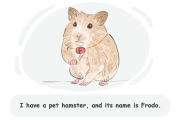Compound Sentences
In this lesson we learn about compound sentences, which are essential sentence structures that combine two or more independent clauses using conjunctions or punctuation. Clear explanations and practice exercises to help you learn.

What Are Compound Sentences?
Compound sentences are sentences that have at least two independent clauses. These independent clauses are joined using a semicolon or a conjunction.
What Is an Independent Clause?
An independent clause is a finite clause that has a subject and finite verb and forms a complete thought.
This dress is too expensive, and that hat is too small.
This sentence is a compound sentence, because it has two independent clauses: 'This dress is too expensive' and 'that hat is too small', separated by a comma and the conjunction 'and'.
Compound Sentences: Form
As already mentioned, each compound sentence consists of two or more independent clauses. Specific structures are used to connect the two clauses in the compound sentence: coordinated clauses and clauses connected by semicolon.
Coordinated Clauses
Coordinating conjunctions (also called coordinators) are used with a comma to join independent clauses together. Here are the coordinators you can use to join independent clauses:
and
but
or
Punctuation
When two independent clauses are connected using a coordinating conjunction, a comma must be used before the conjunction. For example:
We can watch a movie, or we can go out for dinner.
I wanted to go to the park, but it started raining.
Tip!
When two clauses with the same subject are coordinated using a coordinating conjunction, the subject can be omitted from the second clause by ellipsis. However, the resulting sentence will be a simple sentence rather than a compound one.
I like reading books and enjoy watching movies.
This is simple sentence, not a compound one.
Clauses Connected by Semicolon
Two independent clauses can also be connected using a semicolon, without any conjunction, to form a compound sentence. Remember that using a comma in this structure is grammatically incorrect. Look at the examples:
I was tired; I had been working all day.
It was late; we decided to go home.
Conjunctive Adverbs
Conjunctive adverbs can also come after a semicolon to help form compound sentences by explaining the relationship between the two clauses. In this structure, they need a comma after them. Some of the common English conjunctive adverbs are:
however
therefore
moreover
indeed
at least
They didn't study; therefore, they failed the test.
The test was difficult; nevertheless, he passed.
Tip!
Remember to use a lowercase letter at the beginning of the second independent clause. Because a compound sentence is a single sentence, only the first letter of the first word is capitalized.
What Are Compound Sentences Used for?


compound sentences are commonly used to form smooth and fluent texts. They can be used to combine two or more complete and related sentences into a single one. A compound sentence brings together individual, related ideas to form a single sentence.
Simple sentence #1: I have a pet hamster.
Simple sentence #2: Its name is Frodo.
Compound Sentence: I have a pet hamster, and its name is Frodo.
To combine them into a compound sentence, we simply add a comma and the coordinator 'and'.
I have a pet hamster; its name is Frodo.
Alternatively, we can make a compound sentence using only a semicolon and the sentence would still be correct.
Even though these two simple sentences talk about the same thing, the subject of each sentence is different: the subject of the first sentence is I and the subject of the second one is name. That's why they are considered independent clauses. Now, look at the example below which is not a compound sentence:
I have a pet hamster named Frodo.
In this sentence, "named Frodo" acts as an adjective for the noun "hamster". It is a non-finite clause without a subject or finite verb and so does not form an independent clause.
Tip!
The following sentence is not a compound sentence, because it only has one subject, and the clause after the conjunction 'and' is not an independent clause.
He went to a restaurant to eat lunch and meet his friends.
However, this sentence can be turned into a compound sentence by adding another independent clause with a second subject:
He went to a restaurant to eat lunch and meet his friends, but he forgot to bring his wallet.
Compound Sentences with Imperatives
Imperatives normally do not show their subjects, because they are implied. So the following imperative sentence is a compound sentence with two subjects:
Come here at once, or I will come to you!
Review
A compound sentence joins two or more related independent clauses. Each sentence or independent clause must have a subject and a verb.
She went to the park, but he stayed at home.
Quiz:
Which of the following is a compound sentence?
She went to the store and bought some groceries.
She went to the store; she bought some groceries.
She went to the store because she needed groceries.
She went to the store, buying some groceries.
Sort the words to make a correct compound sentence.
Match each incomplete sentence with the correct ending.
Fill in the blank with the correct conjunction or conjunctive adverb to complete the compound sentence:
I wanted to go to the park,
it started raining.
He played soccer in the rain,
he didn't mind getting wet.
The movie was exciting;
, the ending was disappointing.
I didn’t bring my umbrella;
, I got wet in the rain.
Which of the following is a correctly formed compound sentence?
She was late; and missed the bus.
He went to the store; he bought groceries.
The sun is shining, however, it is still cold.
I want to go swimming Or eat ice cream.
Comments
(0)